Table of Contents
Anthracite
Small power-driven, toothed, cast-iron rolls were used first to break anthracite in 1844. Prior to that time, men with hammers, who stood on perforated cast-iron plates, broke the large lumps into commercial sizes.
In order to convert run-of-mine into the various sizes required by the anthracite industry, about 20 million tons must be broken, annually, into smaller sizes. This phase of anthracite preparation is of major importance, because the degradation accompanying reduction in coal sizes should be kept at a minimum. The exclusive use of toothed rolls for that purpose indicates that comminution by rolls is the best solution of the problem.
Coal breaking and crushing practices in anthracite breakers involve the use of equipment for comminuting the following classes of material:
- Run-of-mine—plus 6½-in. coal.
- Sized coal-steamboat, broken, egg, stove, nut, and pea.
- Flat coal—coal that is flat and hence not suitable for the market.
- Bone—a piece of laminated coal and slate, crushed for the purpose of reclaiming the coal.
- Breaker refuse, reduced to a size suitable for flushing into a mine for back-filling purposes.
- Large lumps of rock and refuse, reduced to a size sufficiently small for disposal by means of conveyors.
Toothed double rolls are used for the conditions described in items 1 to 4 inclusive, hammer crushers for 5, and gyratory crushers for 6.
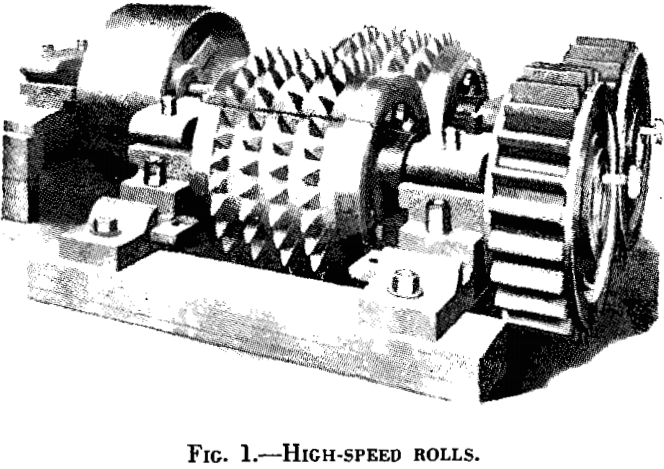
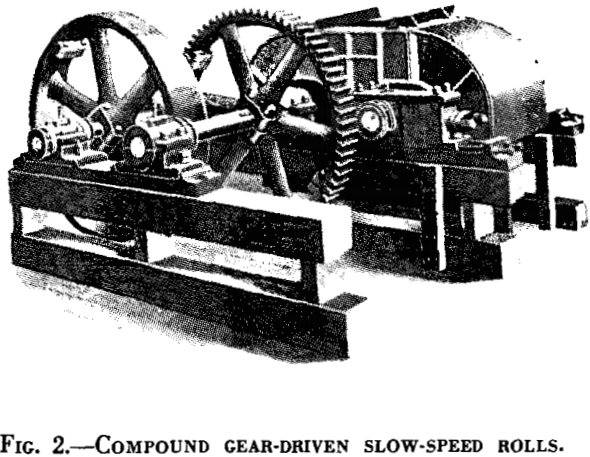
Roll Tests—The object of a roll test is to determine the percentages of the various sizes that are produced when a weighed sample of the feed is crushed. When making a roll test, care should be taken to get a representative sample of both the feed and the crushed material. Roll tests are the yardsticks to measure the crushing performance of a pair of rolls. Tests give information on the condition of the teeth, whether sharp or dull; the correctness of roll spacing; the percentage of prepared sizes obtained; and the amount of degradation. Tests of the rolls in various breakers are not
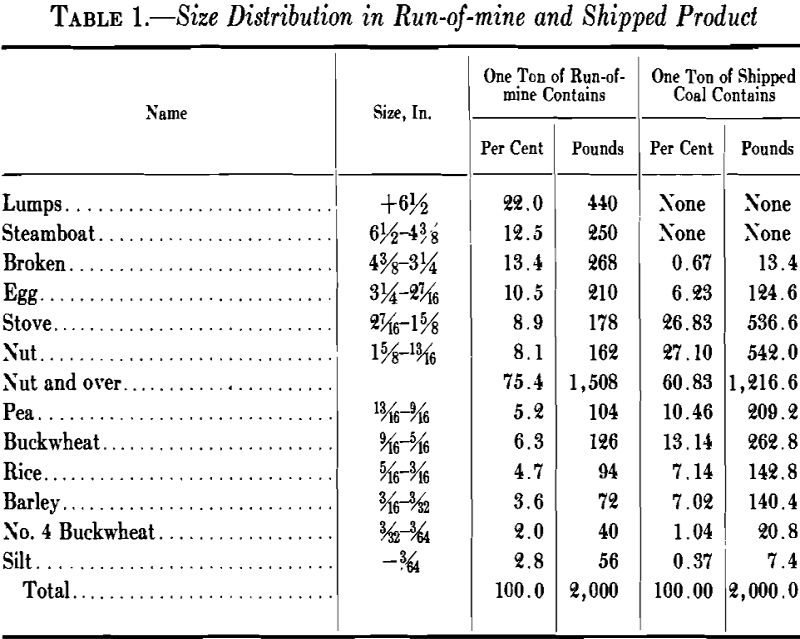
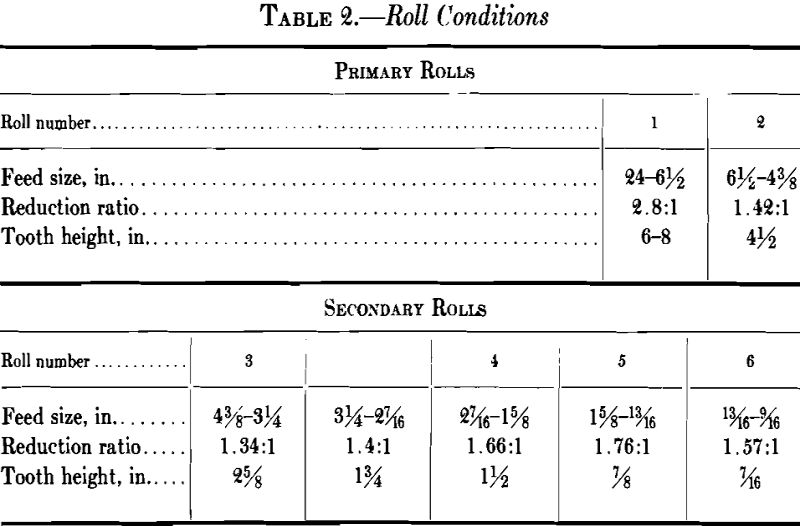
entirely comparable, because some mines produce a product more friable than others.
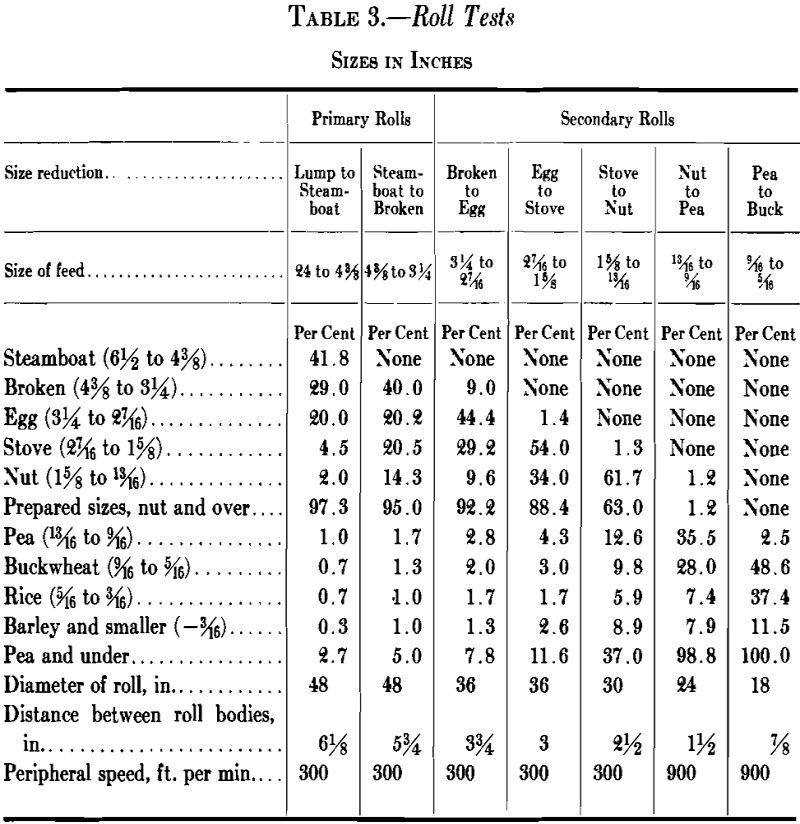
Roll Design.—Roll design, in general, involves the use of heavy iron or steel castings, in order to withstand the severe shocks caused by the entrance of large lumps of coal and rock or tramp iron. To further avoid the destruction of the rolls, the pedestals of one shaft are equipped with relief springs, which make it possible for one roll to move outwardly and thus allow foreign material to pass through.

Main roll gears have large teeth with a circular pitch of from 3 to 4-in., thereby making possible a strong tooth of sufficient height to permit safe and satisfactory operation, even though the pitch circles of the gears lack ½ to ¾ in. of being tangent. Some main roll gears (removable rim gears) are designed so that they
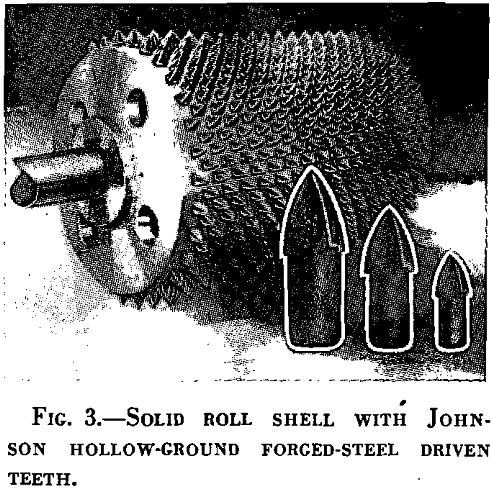
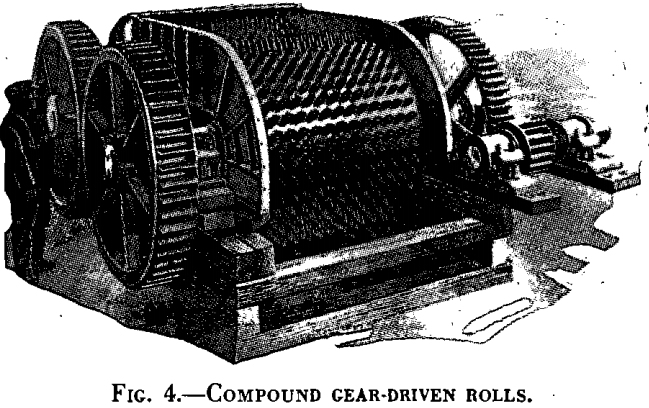
may be bolted to the gear spiders. This construction allows the gears to be changed without removal of the spider, which is keyed to the roll shaft.
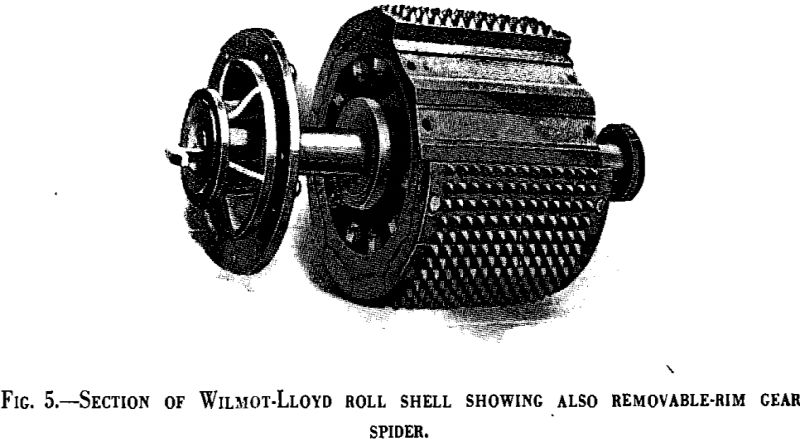
Bituminous
Given but a casual glance, crushing of bituminous coal appears to be a simple mechanical reducing operation. However, each crushing project is a separate engineering problem. As discussed later, the type of coal plus the market requirements are the major factors the engineer must consider. He must also understand the advantages of the many types of excellent machines offered, the principles of crushing circuits, the variations in installation and operating costs, and the principles of crushing analysis.
Changes in Crushing Requirements.—Prior to 1930, there was little crushing of bituminous coal. In most areas the market required only three sizes: lump, nut, and slack. A few mines prepared a fourth size of varying

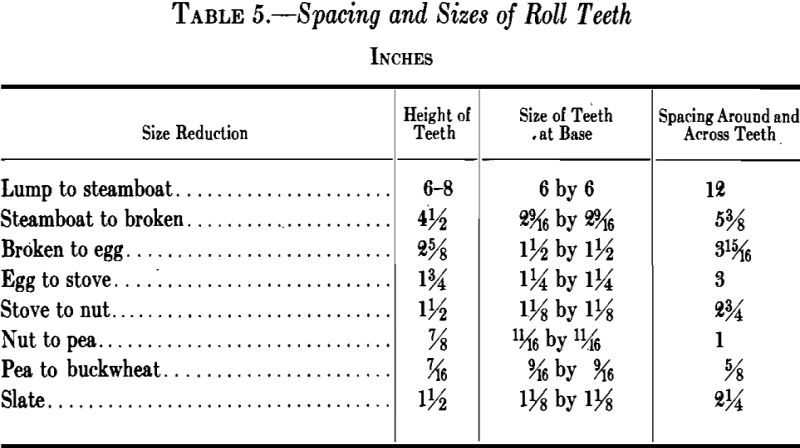
dimensions, as a so-called specialty. All of these products required screening only. Lump was a favored product and was extremely large. Slack was a low-priced item; and not infrequently it was a stepchild no one wanted.
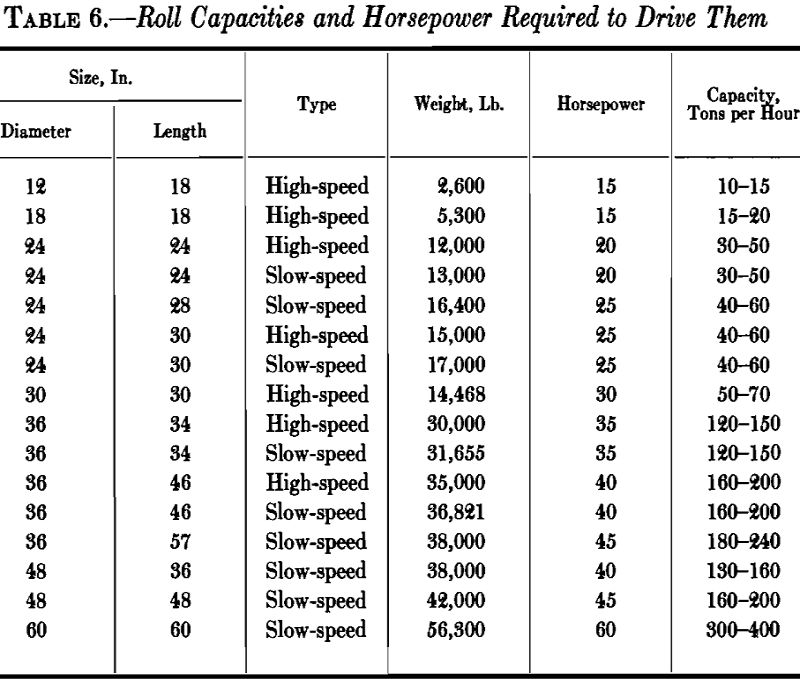
A second factor was the spread of coal washing, which required a feed of top size on the order of 6 to 8 in. Accordingly, the breakers were altered to bring the lump size down to suitable dimensions. Most of the old breakers could be changed by installing new segments with different crushing teeth.
With these changes in crushing operations, there were also changes in efficiency requirements. Efficiency means not only lowest possible operating cost but lowest possible fines tonnage. Often it also means a demand for minimum volume of oversize, and even a complete elimination of oversize on contract work, a requirement seldom heard of prior to 1930.
How Fines are Produced.—Reduction is accomplished in three ways: by splitting, by an impact or blow, and by compression. Examples of impact coal crushers are hammer mills and rotary breakers. Some double-roll breakers also induce a blow action. Roll crushers of various designs fall into the classification of compression units, though they include, along with squeezing, a subsidiary action analogous to splitting or cutting as teeth meet the coal. In all the units there is abrasion of coal to some degree, depending on the type of mechanical action employed in the crusher. Manufacturers are continually improving crusher design to reduce abrasion as much as possible analyzed. Variations in sizes, volume of sizes, specifications for percentage of fines, and friability of the coal must be considered. Tests to establish crushing characteristics are essential for efficient design. Results from other operations can be considered only as guides, not specifications.
When studying a crushing problem, the preparation engineer must determine: (1) maximum size of lumps in feed, (2) friability, (3) incidence of stone, (4) tons per hour feed, normal and maximum, (5) sizes required in final product, in volume, (6) allowances for oversize and fines.
Crushing tests vary to some extent as to technique but the basic operations are essentially the same. It is necessary first to analyze the feed by screening. The number of separations depends on the marketable sizes in prospect and on the condition of the coal. The screenings are weighed for volume. The separated sizes are then run through the crusher and rescreened to determine the product. In this phase the settings may be varied for the same size of feed, to determine variations in crushed product. Screening tests following crushing must always be sufficient to determine the possible volume of marketable sizes, plus the probable fines and oversize.
Bituminous-coal crushing technique has progressed to the extent where it is common practice to divide the reduction into stages. Setting up stage circuits offers advantages in stabilizing production of wanted sizes with consistent efficiency. When the prime requirement was lump, the mechanical problem was the breaking to marketable lump with as little handling as possible. Normally this was done by a single pass in one crusher. Specifications calling for a large volume of small screenings make the mechanical problem much more complicated. By reducing the setting of existing coarse crushers, a reduction in size can be made, but at the expense of making an undesirable amount of the extremely fine sizes.
Coal-breaking Operations
Four prime factors affect the plan for breaking run-of-mine coal as it enters the preparation plant: (1) size of lump, (2) incidence of stone, both in volume and size, (3) friability of the coal, and (4) the preparation operations that follow.
Bituminous run-of-mine ranges in size from zero to extremely large lump. It is the size of this lump that determines the size of the breaker. For instance, if lump in the feed runs 10 to 15-in. for a large part of each hour, but lump 30 to 40-in. comes over once an hour, even for only a brief period, the larger lump sets the size of the machine.
Circuits for primary breaking are relatively simple. One common type is for delivery from breaker to washers through a shaking classifying screen. Another common type simply transfers the breaker product to another point in the plant with a conveyor.
A mechanical solution for excessive rock is the rotary breaker. Modern breakers of this type carry stone on through the machine and disgorge it as a refuse. The coal passes through the perforations in the drum and into the plant circuit. Modern rotary breakers are designed with open ends, to prevent rock from lodging in the spokes.
Rock-type single-roll crushers are being used increasingly for crushing run-of-mine and for crushing coarse picking-table refuse and mine rock to a size convenient for handling on conveyors and aerial trams.
All single-roll crushers must have a relief mechanism that will permit passing of tramp iron or hard refuse that defies breaking. In some machines, the breaker plate swings away to pass material, while in others the roll itself rises against the pressure and drops back when the hard substance is evacuated.
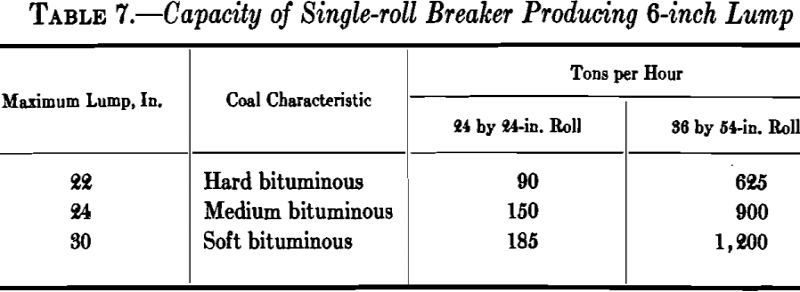
and sizes of product chosen are those most commonly used or those which easily indicate the range of capacity of the machine. Manufacturers furnish reliable tables of capacities for a wide range of sizes for both raw lump and final product, for specific crushers.

